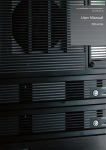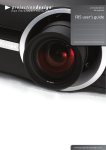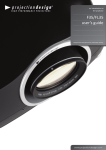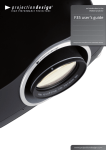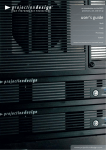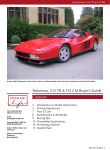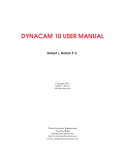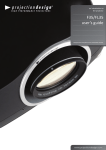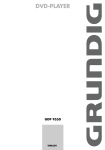Download Projectiondesign Action one mk III User`s guide
Transcript
an introduction to the processors, use and set up user’s guide Multi Image Processing System Designed and manufactured in Fredrikstad, Norway. www.projectiondesign.com english Multi image processor User’s Guide – Introduction 2 english 1 Introduction 1.1 Thank you Thank you for purchasing a Multi image processing system processor. The Multi image processing systems WB2560 and WB1920 are state-of-the-art image processing engines for the combination and setup of multiple projectors in order to create one, large, seamless image. By combining multiple projectors, images with unprecedented resolution and fidelity can be created. The multi image processing system processors feature unique functionality and unmatched compatibility, and are perfectly tailored to working with projectiondesign projectors for use in multi-image environments. 1.1 Features • Geometry correction • Blending and overlap • 2560x1600, and 1920x1200 models available • User selectable algorithm setups • 4x4 Lanczos scaling • Bi-linear scaling • B-cubic scaling • Project onto any surface • Zero, or near zero latency, depending on set up and configuration • 3D stereo compatible, up to 1920x1200 on WB2560, and 1280x800 on WB1920 • Patented Black Level Matching for uniform black levels • Per-pixel Colour-, Uniformity-, and brightness matching • 12-bit internal resolution • Dual-Link DVI-D in / out • All control through Ethernet • Built-in power supply for easy power management in large racks • Integrates seamlessly with projectiondesign ProNet multi image processing system software setup suite • Rack mount, ½ width, 1U height • Unlimited scalability and channel count • Fully transparent to source, no special software or source requirements 3 www.projectiondesign.com english Contents of this User’s Guide 1Introduction 3 1.1 Thank you 1.1Features 2SAFETY 7 2.1 GENERAL WARNINGS 2.2 WEEE INFORMATION 2.3 WARNING ABOUT SUBSTANCES 2.3.1 WARNING SYMBOLS 3 What’s in the box? 9 3.1 The multi image processing system comes with the following: 4 Installation and setup 11 4.1 System requirements 4.2 System overview 4.3Connectors 4.4 LED indicators / Front button 4.5 Network settings 4.6 Firewall settings 4.7Software 4.8 Mounting the multi image processing system processor in rack 5 Getting to know the GUI 15 5.1ProNet.site 5.2 WB Calibrator – Device View 5.2.1 Creating and saving a multi image processing system setup project 5.2.2 Backing up and restoring calibration 5.2.3 Adding multi image processing system units to a project 5.2.4 Using the Device View Toolbar, DVT 5.2.5 Clearing calibration 5.2.6 Notifications and advanced network settings 5.2.7 Performing software upgrades 5.2.8 Controlling EDID information 5.3 WB calibrator – Calibration View 5.3.1 Using the Calibration View Toolbar (CVT) 5.3.2 Selecting/deselecting multi image processing system units 5.3.3 Using the Calibration Panel Toolbar (CPT) Multi image processor User’s Guide – Introduction 4 6 Geometry correction english 5.4 Multi image processing operational states 5.4.1 Bypass states 5.4.2 Calibration state 5.4.3 Online state 5.4.4 Auto state 27 6.1 Warping algorithms 6.1.1Perspective 6.1.2 Mesh Warp Transform 6.1.3 Mesh Warp Bezier 6.2 Warping user interface 6.3 Scaling filters 6.3.1 Lanczos filter 6.3.2 B-spline filter 6.3.3 C-spline filter 6.3.4 Linear interpolation filter 6.4 Working with the perspective algorithm 6.5 Working with the Mesh Transform algorithm 6.6 Working with Mesh Bezier algorithm 6.7 Fine tuning control points 6.8 Real Time Warp 7 Edge blending 35 7.1Introduction 7.2 Edge blending algorithms 7.2.1 Basic edge blending 7.2.2 Advanced edge blending 7.2.3 User interface for basic edge blending 7.2.4 User interface for advanced edge blending 7.2.5 Adjusting the shape of advanced edge blending zones 7.2.6 Adjusting the advanced blend drop-off curve 8 Test patterns 8.1 8.2 8.3 8.4 5 41 Circle test pattern Grid (Pixel) test pattern Grid (Angle) test pattern Turning test patterns on and off www.projectiondesign.com english 9 Black Level Management 45 9.1 Creating adjustment zones 9.2 Removing BLM zones 9.3 Adjusting black level in a defined zone 10Masking 49 10.1Adding areas to clip 10.2Removing clip areas 11 Storing and recalling data 53 11.1Storing/recalling calibration to/from the multi image processor unit 11.2Storing/recalling data to/from the control PC 11.2.1 Restoring calbration files 11.3Accept calibration 12 Technical specifications 57 12.1Electrical 12.2Mechanical Multi image processor User’s Guide – Introduction 6 This device complies with safety regulations for Information Technology Equipment intended to operate in “normal” environments (offices and homes). Before using the device for the first time, please read the safety instructions thoroughly. english 2 SAFETY 2.1 GENERAL WARNINGS Use only the cables and cords supplied with the device or original replacement cables. Using other cables or cords may lead to malfunction and permanent damage of the device. Always use 3-prong / grounded power cord to ensure proper grounding of the device. Never use 2-prong power cords, as this is dangerous and could lead to electrical shock. Never open the device. The device contains no user serviceable parts. Refer all repairs to qualified personnel only. Make sure that no objects enter into the vents and openings of the set. Do not spill any liquids on the device or into the vents or openings of the device. Always remove protective plastic covering the device before operating the device. Only place the device on a stable surface, or mount it securely in a rack. Do not drop the device. The device can be used as desktop or rack mounted with the certification labels facing down. Any other mounting directions are not allowed. When rack mounted, care must be taken to keep ventilation on back and front sides open. Operating the device in other positions may lead to overheating, resulting in malfunctioning. Always allow ample airflow through the device. Never block any of the air vents. Never cover the device in any way while running. Allow for sufficient distance to walls and other obstructions to avoid overheating. Minimum safety distance to front or rear of the device is 20 cm (8”) to rear and 5 cm (2”) to front. The device is designed for indoor use only. Never operate the device outdoors. Do not operate the device outside its temperature and humidity specifications, as this may result in overheating and malfunctioning. Only connect the device to signal sources and voltages as described in the technical specification. Connecting to unspecified signal sources or voltages may lead to malfunction and permanent damage of the device. 2.1 WEEE INFORMATION This product conforms to all requirements of the EU Directive on waste electrical and electronic equipment (WEEE). This product should be recycled properly. It can be disassembled to facilitate proper recycling of the individual parts. Consult your dealer or relevant public authority regarding drop-off points for collection of WEEE. 7 www.projectiondesign.com english 2.1 WARNING ABOUT SUBSTANCES This product contains chemicals, including lead, known to the State of California to cause birth defects or other reproductive harm. Recycle properly, do not dispose of in ordinary waste!. 2.1.1 WARNING SYMBOLS READ USER GUIDE Attention! Read the user guide for further information! RECYCLE Warning! Recycle properly, do not dispose of in ordinary waste! NO TELEPHONE Warning! Do not connect to telephone lines! Multi image processor User’s Guide – Safety instructions 8 3.1 The multi image processing system comes with the following: english 3 What’s in the box? Multi image processing system unit Power Cable (Country Dependant) 2x Dual Link DVI cables CD with software Network cable User Documentation Please verify that you have all compoents upon unpacking the unit, and its contents. Please save packaging materials for future use, should it be necessary to ship the unit. 9 www.projectiondesign.com english Multi image processor User’s Guide - What’s in the Box? 10 The following section outlines the general requirements to supporting equipment in order to run the ProNet Calibrator and successfully setting up a multi image based projection system. english 4 Installation and setup 4.1 System requirements ProNet 2.0 – required to set up and operate multi image processing system processors, works with Microsoft Windows® operating systems only. The following versions are supported: • Windows XP (32-bit only), SP xx or • Windows Vista (32- or 64-bit) • Windows 7 (32- or 64-bit) In addition, Microsoft .NET Framework 3.5 or later must be installed. Any standard computer capable of running the above operating systems should work, but for best performance, the computer running ProNet 2.0 should have at least: • Intel® Dual Core™ architecture or similar. • 2 GB of RAM • 200 MB of free disk space • 1.0 Gigabit Ethernet interface Note! For the ProNet application to be displayed correctly, 96 DPI must be used (Windows Default). 11 www.projectiondesign.com english 4.2 System overview A multi image processing system contains the following main components: • An Image Generator (IG) with one or more channels (outputs) (not provided by projectiondesign). • One multi image unit per channel • One projector per channel • A PC for setup and control • Optional CAD tool for designing systems (not provided by projectiondesign) Figure 4-1 shows a complete system overview of a multi image processing setup. PROCESSOR PROCESSOR PROCESSOR Figure 4-1. Multi image processing system overview 4.3 Connectors Connector Panel: • Power connector/switch • 2 x DVI-connectors • LAN-connector • RS232-connector (for service only - do not use) • Kensington Lock slot Figure 4-2. Connector panel Multi image processor User’s Guide – Installation and setup 12 The front button and the Power and Status LED-indicators on the processor front panel have the following functions: Front button: Push 1 time: Show info on screen (visual ID/IP/present serial no.) Push 3 times: Reboot Press and hold 5 seconds: Network reset Press and hold 15 seconds: Factory reset Power LED: Status LED: BLUE: ON GREEN: ON BLUE: Blinking • Booting up GREEN: Blinking • DVI IN not valid and/or • Network not OK YELLOW: Blinking • Upgrading software RED: ON • Temperature too high english 4.4 LED indicators / Front button Figure 4-3. Front button and LED-indicators 4.5 Network settings For optimum performance during calibration, a 1.0 Gbps Ethernet connection is recommended. 100 Mbps will also give adequate performance. The communication between the control PC and multi image processing system units is based on a bidirectional XML protocol. We recommend that any firewall between Control PC and multi image processing system units should be disabled. Multi image processing system processors support DHCP in a network environment. Static IP addresses can be set if there is no DHCP server available. Processors also support Zero configuration networking (zeroconf). Note! It is recommended that the multi image processing system processors and the ProNet Control PC are run in a dedicated network environment. 13 www.projectiondesign.com english 4.6 Firewall settings The multi image processing system processor communicates extensively on the network. In order for it to communicate freely with the ProNet application, the following ports must be open in the firewall: • 22 outbound (SSH) • 1900 inbound (UPnP open for AutoDiscovery of multi image processing system processors) • 30000 outbound (dedicated multi image processing instruction command set) • 40400 outbound (dedicated ASCII command set) • 49500 - 49600 inbound (configurational range; one port number per multi image unit) Note! The firewall must not filter Ping on LAN (ICMP Type 8 (ICMP Echo Request)). 4.7 Software To the use multi image processing system, ProNet.site must be installed on a control PC. The latest version of the software can be found at www.projectiondesign.com A license key is required to use the software. The key can be acquired by contacting an authorised projectiondesign representative. 4.8 Mounting the multi image processing system processor in rack Each multi image processing system processor is half-width, 1U standard size, so two channels can be combined in a single standard 19” 1RU rack mounting plate, available from projectiondesign. Remove the upper and lower screws on each side of the multi image processing system processor, position the mounting plate and reenter the screws as shown in Figure 4-4 and Figure 4-5. Figure 4-4. Rack mount plate Figure 4-5. Rack mounted Multi image processor User’s Guide – Installation and setup 14 5.1 ProNet.site english 5 Getting to know the GUI Figure 5-1 gives an overview of ProNet.site. The application has four main areas of interest: • The File menu located in the top-left corner. • The “Site Devices” overview on the left hand side of the GUI. • Control, status, monitoring and timed operations overviews for one or more selected devices on the right hand side. • Status messaging window at the bottom. Figure 5-1. Overview of ProNet.site To start the multi image processing system calibrator (referred to as WB - warp & blend in menus) plugin, select “Control Panels” > “Predefined” > “WB calibrator”. Licence key required to see more than one device (see section “4.7 Software”) Enter lisence key: File menu <Help> license key. Enter key and other information as per provided key. 15 www.projectiondesign.com english 5.2 WB Calibrator – Device View Figure 5-1 shows the “Device View” window that is displayed when the “WB Calibrator” plugin is started. The “Device View” window contains the following areas: • The File menu located in the top-left corner • The Device Pool window in the lower left corner. • A multi image processing system information window in the lower right corner. • A dedicated toolbar on the left hand side. • A Device View Desktop that is displayed in the centre of the ProNet application window. All multi image processing system units added to a project are shown here along with their arrangement. Figure 5-1. WB calibrator, Device View. 5.2.1 Creating and saving a multi image processing system setup project When starting the multi image processing system calibrator, a new project will be started automatically. In the Device View, a project contains the multi image processing units added, and their arrangement in the Device View desktop. Projects can be saved and opened on the control PC. This is done from the File menu. See Figure 5-1. Note! Project files are saved as XML files. Project files are saved on the control PC, not in the multi image processing unit itself. 5.2.2 Backing up and restoring calibration Calibration files for each multi image processing unit in a project can be backed up or restored from the File menu. Backup files are stored on the control PC, not in the multi image processing unit itself. Multi image processor User’s Guide – Getting to know the GUI 16 english Figure 5-1. File menu, Device View. 5.2.3 Adding multi image processing system units to a project To enable and add multi image processing system units to a project, simply drag and drop units from the tree view in the Device Pool (Figure 5-1) to the Device View Desktop. The multi image processing system units in the Device Pool are detected using ProNet’s built-in universal plug-n-play capability. Figure 5-1. The Device Tree in the Device Pool. Multi image processing system units can also be added or deleted from the Device View Desktop by using the 17 and icons in the toolbar. www.projectiondesign.com english 5.2.4 Using the Device View Toolbar, DVT The Device View Desktop window has a toolbar on the left hand side, known as the Device View Toolbar. The toolbar can be shown with or without help texts, see Figure 5-1. Figure 5-1. Toolbars, shown with and without help texts. Using the toolbar you can: • Add or remove multi image processing system units from a project. • Select or deselect all multi image processing system units on the Desktop. • Show an information window for a selected unit. The information window shows system status (temperature, fan operation, DVI signal detection in/out) and system versions for software, hardware, FPGA, and more. • Using the Configuration tool, Visual ID (on screen identification) and custom notes are configured. System latency is also set up from this menu. • The Basic Blend page sets the number of overlapping pixels for the selected channel(s). The blend drop-off curve is also configured here. • Identify is used to configure display of visual ID information, and identify units on the Desktop. Extended visual ID mode will, in addition to showing your custom Visual ID, show network information and serial number of the unit. • Bypass sets the unit in bypass mode. No processing occurs. • Online. This switches the processor to full processing mode. The signal on the DVI input will be processed according to set calibration and passed to the DVI output connector. • Mute or unmute more units Most of the features accessed from the toolbar menu are also available by right-clicking a selected unit, and choosing it from the context sensitive menu that shows up. Multi image processor User’s Guide – Getting to know the GUI 18 To clear calibration from selected multi image processing system units, select Edit > Clear Calibration from the File menu. Under Clear Calibration, one can select to clear all or just parts of the calibration. See Figure 5-1. english 5.2.5 Clearing calibration Figure 5-1. Clearing calibration 5.2.6 Notifications and advanced network settings Under Settings > Application Settings, message notification levels and advanced network settings are configured, see Figure 5-1. Figure 5-1. Application and Network settings. 5.2.7 Performing software upgrades All multi image processing system units can easily be upgraded via the ProNet 2.0 user interface. System software is available from www.projectiondesign.com. Select Maintenance > Multi Image Processor Software Update. The window shown in Figure 5-1 appears. Locate the system update file(s), typically mips-system-008.0001.02.00.tgz, and click “Select..”. After the file has loaded successfully into the update application, click “Start”. IMPORTANT: This is just the first step in the upgrade process. When the progress bar has reached 100%, the unit will start to reconfigure itself for the new software. This configuration can take up to 15 minutes. IMPORTANT: Do not unplug the power during this process! 19 www.projectiondesign.com english The software update process is complete when the power status LED on the unit is showing a steady blue light. Figure 5-1. Multi image processing software upgrade window. 5.2.8 Controlling EDID information The unit defaults to giving the image generator either WUXGA or WQXGA EDID data depending on the version of the multi image processing system unit that is in use. EDID data can also be configured manually, or the unit can pass EDID data information from the projector directly to the image generator (referred to as “EDID sink”). To manipulate EDID setting, select Maintenance > EDID Administrator. Select the EDID file you want to use and click “Activate”. Verify that the selected EDID is applied, see bottom of window Active EDID. For passing the EDID data directly from the projector to the image generator, select edid_sink.bin. The EDID Administration window is shown in Figure 5-1. Figure 5-1. EDID Administration. Multi image processor User’s Guide – Getting to know the GUI 20 When all multi image processing system units are added to the project in the Device View, switch WB Calibrator to “Calibration View”. This is done by clicking the “Calibration View” button in the top-left corner. Clicking the same button in Calibration View mode will bring you back to Device View. See Figure 5-1. english 5.3 WB calibrator – Calibration View Figure 5-1. Switching views from Calibrator view to Device view and back. 5.3.1 Using the Calibration View Toolbar (CVT) Like in Device View, Calibration View has its own toolbar on the left hand side of the screen. This is called the Calibration View Toolbar, CVT. The toolbar can be shown with or without help texts, Figure 5-1. To enable the help texts, click the question mark. Figure 5-1. Calibration toolbar, without and with help texts. 21 www.projectiondesign.com english 5.3.2 Selecting/deselecting multi image processing system units The WB Navigator is a window used to select multi image processing system units in a project, Figure 5-12. In this window, WB units can be selected or deselected either by clicking on them or using the assigned short cut key combination. Figure 5-1. WB Navigator Similar selection capabilities can be found in the top toolbar, Figure 5-1. In this toolbar automatic arrangement of open windows can also be done. Figure 5-1. Top toolbar window navigation Multi image processor User’s Guide – Getting to know the GUI 22 The calibration panel has a set of tools on the left hand side of the window. This toolbar can be shown with or without help texts, “Figure 5-1. Calibration Panel Toolbar, without and with help texts.” english 5.3.3 Using the Calibration Panel Toolbar (CPT) Figure 5-1. Calibration Panel Toolbar, without and with help texts. 23 www.projectiondesign.com english The Calibration Panel Toolbar has these main functions: • Zoom. Scale the work area in the calibration panel. • Image Orientation. Change the orientation of the calibration panel to match the physical orientation of the projector (e.g. rear/ceiling or portrait). • Set Colors. Set the color for background, lines, control points and internal test patterns, see Figure 5-1. Figure 5-1. Set colors control box • Layers. Calibration layers for warping, blending, test patterns and other can be turned on and off for easier setup. • Hide Inactive. Hide inactive controls. Only active points will be visible on the WB output display. • Active Guide Points. When using Mesh Bezier Warp or Bezier lines in clipping (masking) or black level management feature, the Bezier functionality (control points) can be turned off. The Selected line will have a linear behaviour. • Show Point Setup. Show Control Point Setup when a control point is selected. Location specifies the x and y position of the current control point. In Bezier Guide Point Configuration the control point can be configured to be symmetric, corner or smooth. - Symmetric. Corresponding guide points will have identical strength and angle. - Corners. Guide points will be independent in both strength and angle. - Smooth. Corresponding guide points will have identical angle. Figure 5-1. Control point setup Multi image processor User’s Guide – Getting to know the GUI 24 • Bezier Fixed Length/Angle. Specify the bezier guide point behaviour. Off allow adjustment of both length and angle. Fixed length allows the user to change angle, but not the length. Fixed 1/3 length will fix the length to 1/3 when the control point is moved. Fixed angle allow the user to change the length while the angle is fixed. english • Show info labels. Show extra info for selected control point. Figure 5-1. Bezier point settings • Straighten Line. Can be used to straighten selected Bezier lines (short cut key: Ctrl + L). • Control Point. Up, down, left and right arrows. Use to move between control points or move a control panel one or 1/10 of a pixel. 5.4 Multi image processing operational states Multi image processing system can operate in 4 different states: Bypass, Calibration, Online or Auto. Switch between the different states using the action toolbar. 5.4.1 Bypass states The DVI input signal is bypassed through the system and passed to the DVI output. 5.4.2 Calibration state Calibration mode is used to configure the system. Different test patterns will be shown depending on what type of calibration is being performed (warp, blend, masking etc.). The Multi image processing system unit will automatically enter calibration state upon clicking on any of the calibration tools in the actions toolbar. 5.4.3 Online state In online state the DVI input signal is processed according to the calibration and sent to the DVI output. 5.4.4 Auto state When a calibration is completed and the accepted calibration is stored in multi image processing system unit auto state will be used upon power up of the unit. If the multi image processing system find a stored calibration that matches the input resolution, it will enter online state (image processing enabled). If no calibration is found, the unit will be in bypass state. 25 www.projectiondesign.com english Multi image processor User’s Guide – Getting to know the GUI 26 Image Geometry Correction (often referred to as Image Warping) is the process of digitally manipulating image data so that the image’s projection precisely matches a specific projection surface or shape. Image Geometry Correction compensates for the distortion created by off-axis projection or screen placement or non-flat screen surfaces by applying a compensating inverse distortion to the image in the digital domain. Usually, Image Geometry Correction is applied so that areas of the projection surface are perceived by the viewer to map to the corresponding areas in the source image. english 6 Geometry correction 6.1 Warping algorithms The multi image processing system supports 3 different warping algorithms: Perspective, Mesh Warp Transform, Mesh Warp Bezier. The best way to understand how they work is to test the different algorithms in an actual system setup. One projector and one multi image processing system unit is enough to learn how they work. Note! Image Geometry Correction is not applied until operational mode is changed to “online”, which enable you to see the result. 6.1.1 Perspective This is advanced keystone. Only the four corners of the image can be manipulated. 6.1.2 Mesh Warp Transform This is recommended for use on simple, slightly curved screens. The number of control points can be dynamically added. Start off with a few control points and increase the grid size as needed. When the grid is increased, the position of any added point in the finer grid mask will be given a correct position automatically. Maximum grid size is 16x16. 6.1.3 Mesh Warp Bezier This is a very powerful tool where you can manipulate not only the control points of the grid, but also the tangent vectors connected to every control point. The control points of the tangent vectors are called Bezier control points. Bezier patch meshes are superior to meshes of triangles as a representation of smooth surfaces, since they are much more compact, easier to manipulate, and have much better continuity properties. In addition, other common parametric surfaces such as spheres and cylinders can be well approximated by relatively small numbers of cubic Bezier patches. Maximum grid size is 16x16, but the flexibility of this algorithm usually allows for correct geometric distortion with very few control points. 27 www.projectiondesign.com english 6.2 Warping user interface To apply warping to an image, select “Warp” from the left hand toolbar. The window in Figure 6-1 will appear. Figure 6-1. Warping algorithm setup Algorithms can be added or removed. If the perspective transform is added first, Mesh Warp Transform can be used in addition. If Mesh Warp Transform or Mesh Warp Bezier is added first, a combination of algorithms is not allowed. In this window, grid size is also configured. For the control points of an algorithm to be visible, the grid size must be at least 1x1. Increasing grid size during calibration is very convenient. This enable for rough calibration with few control points, and fine tuning with increased grid size as needed. Decreasing grid size during calibration is not recommended as you may lose fine tuning data you have already added to the grid. Multi image processor User’s Guide – Geometry Correction 28 Regardless of the warping algorithms selected, a scaling filter will be applied. Scaling filters are configured using the Algorithm Setup window. Select the tab “Filter”, Figure 6-2, and select your desired filter. Four different scaling filters are supported: english 6.3 Scaling filters • Lanczos, B-spline, C-spline, Linear Figure 6-2. Scaling filters 6.3.1 Lanczos filter The Lanczos filter is using a 4x4 kernel. This filter is recommended for use with images that contains large amounts of fine detail, for example text with small fonts. On thin, diagonal or curved lines, some ripple may be encountered. 6.3.2 B-spline filter The B-spline filter available in multi image processing system is of the type Cubic B-spline. This filter is slightly softer than the Lanczos filter, but has better quality on curved and straight lines. In many cases, this filer will give the best image quality and is therefore the default selection. 6.3.3 C-spline filter The C-spline filter is short for Cubic Hermite spline interpolation. It is a filter of third-degree spline with each polynomial of the spline in Hermite form (Named in the honour of Charles Hermite). This filter gives a good combination of smoothness, detail and average ripple on lines. 6.3.4 Linear interpolation filter This filter is also a polynomial filter, but is based on linear interpolation for curve fitting. In modern systems, it will give an unnecessarily low quality image scaling, but some applications may still require the use of this filter. 29 www.projectiondesign.com english 6.4 Working with the perspective algorithm To start working with the perspective algorithm, click the “Warp” icon, add the perspective algorithm and set grid size to 1x1. In order to map the geometry to the surface being projected on, drag the control points with the mouse. Figure 6-3 shows basic usage of the Perspective algorithm. Figure 6-3. Working with the perspective transform Multi image processor User’s Guide – Geometry Correction 30 To start working with Mesh Transform algorithm, click the “Warp” icon, add the Mesh Transform algorithm and start with setting the grid size to 1x1. First map the four corners to their desired location. As required, increase the grid size. This will add more rows, columns and control points to the mesh and enable the possibility to map the grid correctly onto the surface. Figure 6-4 is showing a simple 3x3 grid using the Mesh Transform algorithm. Even though the lines between the control points are not smoothly curved in the user interface, they will be in the multi image processing system unit and hence on the screen. english 6.5 Working with the Mesh Transform algorithm Figure 6-4. Working with the Mesh Transform algorithm 31 www.projectiondesign.com english 6.6 Working with Mesh Bezier algorithm To start working with Mesh Bezier algorithm, click the “Warp” icon, add the Mesh Bezier algorithm and start with setting the grid size to 1x1. The grid you see now will contain four control points – one in each corner. In addition all control point will have 2-4 additional, white control points for controlling the Bezier vectors in a given point, Figure 6-5. Figure 6-5. Mesh Bezier with 1x1 grid First map the four control points (orange) to their desired location. Then move the Bezier control point to curve the lines between to control points to map the screen geometry (Figure 6-6). When using this algorithm, geometry mapping to cylinders, spheres and other well defined surfaces can be done with very few control points. Like with the Mesh Transform algorithms, the grid size can be increased as much as needed to get the required accuracy for a given surface. A 1x1 grid should regardless of the projection surface be used as a starting point. Multi image processor User’s Guide – Geometry Correction 32 english Figure 6-6. Working with Mesh Bezier, simple mapping 6.7 Fine tuning control points To fine tune the position of a warping control point, first click on the control point. Then press and hold Ctrl while using the arrow keys on the keyboard to move the control point. 6.8 Real Time Warp Real Time Warp state can be turned off and on in the Calibration View Toolbar, see Figure 6-7. When Real Time Warp state is Off, the grid will be on display and in the user interface. When Real Time Warp is On, the image from the IG will be shown on the display, while the grid is shown in the user interface. Figure 6-7. Real time warp state 33 www.projectiondesign.com english When Real Time Warp is On, only the active control point will be added to the image from the IG if Show active is selected. Show active can be enabled in the Calibration Panel Toolbar see Figure 6-8. Figure 6-8. Calibration panel guide points NOTE! When working on a warp in Real Time mode, the displayed, warped image will be generated using a linear approximation. When going online the selected algorithm will be used to calculate the online image. There could be a small difference between the image in Real Time warp mode and in online mode. Multi image processor User’s Guide – Geometry Correction 34 english 7 Edge blending 7.1 Introduction Edge Blending is a companion feature to Image Geometry Correction. Edge Blending enables the seamless projection of a large image using several overlapping projectors. Since geometry correction for projection on non-flat surfaces is a built-in requirement in almost all Edge Blending systems, the pairing of Edge Blending and Image Geometry Correction in the same video signal processor is a natural one. 7.2 Edge blending algorithms Multi image processing system support two different types of edge blending: Basic and Advanced 7.2.1 Basic edge blending Basic edge blending is used for simple and slightly curved surfaces. A percentage or a defined number of overlapping pixels is specified. The overlapping region of each side (top, bottom, left, right) of the image is then geometry corrected with the warping that is being applied to the image. 7.2.2 Advanced edge blending Advanced edge blending is used for more complex surfaces like a dome (spherical). With advanced edge blending, warping and blending is completely disconnected. After correct geometry correction has been applied, multiple blend areas are defined to create the seamless image. 7.2.3 User interface for basic edge blending To apply basic edge blending to an image, select “Blend” from the left hand toolbar, and select Basic Blend Setup. The window in Figure 7-1 will appear. Note! Overlap (= shared pixels between two channels) must be applied on the IG. 35 www.projectiondesign.com english Figure 7-1. Basic edge blending. In the Basic Blend setup window, overlapping pixels (or percent) can be specified. The blend drop-off curve of can also be tuned. Tuning the blend drop off curve is also possible when the unit is in Online state, for a visual fine tuning of the curve. Multi image processor User’s Guide – Edge Blending 36 To apply advanced edge blending to an image, select “Blend” from the actions toolbar, and select Advanced Blend Setup. All blend zones will now have to be added manually. Click “Add zone” and select a default location for the blend zone, see Figure 7-2. english 7.2.4 User interface for advanced edge blending Figure 7-2. Adding a blend zone. 37 www.projectiondesign.com english The “Add Blend Zone” window in Figure 7-3 will appear. Configure the initial parameters for the blend zone and click “Add Blend Zone” to add it to the UI. “White” means the location of the full on side of the blend zone (white line). “Black” means the location of the full off side of the blend zone (black line). These blend zone will be completely disconnected from the warping and should hence be applied after the geometry correction is complete. Figure 7-3. Add blend zone window. 7.2.5 Adjusting the shape of advanced edge blending zones Working with the advanced edge blending zones is very similar to the controls of Mesh Warp Bezier. All control points and Bezier points can be used to create the correct shape for the blend zones. Figure 7-4 shows two blend zone, top and left, where adjustments for perfect fit have been done. Figure 7-4. Working with advanced edge blending. Multi image processor User’s Guide – Edge Blending 38 The drop-off curves can be configured individually for advanced blend. Click on a control point in the blend zone you would like to adjust, or select multiple points or blend zones with by dragging a selection rectangle over the areas of interest. Then select “Drop-off Curve” in the Calibration panel toolbar. Adjust the drop-off curve with the vertical and horizontal sliders, as illustrated in Figure 7-5. english 7.2.6 Adjusting the advanced blend drop-off curve Figure 7-5. Adjusting the blend drop off curve. 39 www.projectiondesign.com english Go to custom if you need to change the selected curve or enter a new manually, as seen in Figure 7-6. Figure 7-6. Drop-off curve setup Multi image processor User’s Guide – Edge Blending 40 The multi image processor has several built-in test patterns for easier setup. This tool can be used to tune the geometry (warping) in a setup to match reference points, aspect ratio, ensure visual correctness and to configure 3D image generators for shapes like cylinders and domes. The test patterns are: english 8 Test patterns • Circles. Add circle to your calibration view to visually configure for aspect ratio. • Grid (Pixel). Specify a grid with height and width (in pixels) of all cells in the grid. • Grid (Angle). Specify a grid with horizontal and vertical degrees for setup in domes or cylinders. Multiple test patterns can be used simultaneously. Figure 8-1. Adding test patterns To add a test patterns to the calibration view, click “Test Images” in the actions toolbar. See Figure 8-1. The window in Figure 8-2 will appear. Figure 8-2. Test Image Setup window 41 www.projectiondesign.com english 8.1 Circle test pattern Circles can be added to calibration area to ease the setup. The position (x, y pixel coordinates) and the radius (pixels) can be specified. Figure 8-3 shows the Test Image Setup window with two circles added. Figure 8-3. Circle test patterns Multi image processor User’s Guide – Test patterns 42 A grid with much smaller cells than the calibration grid can be really convenient for setup. Especially when using the Mesh Bezier Warp where the calibration can be done with very few control point. english 8.2 Grid (Pixel) test pattern To add a Grid (Pixel) select the “Grid (Pixel)” tab and specify your parameters (). The parameters are: offset (x, y in pixels for top, left corner) and height and width of the cells in the grid. Use the offset function to make grids in multiple image processor units to overlap. See Figure 8-4. Figure 8-4. Grid (Pixel) test pattern 43 www.projectiondesign.com english 8.3 Grid (Angle) test pattern The last test pattern available in the processor unit is the Grid (Angle) test pattern. This is used to create a reference grid in a dome or a cylinder. Parameters to specify for this grid are ‘to’ and ‘from’ angles (in degrees) in horizontal and vertical direction. The frequency of the reference points can also be specified, as seen in Figure 8-5. Figure 8-5. Grid (Angle) test pattern 8.4 Turning test patterns on and off When using a test pattern it can be convenient to disable the warp calibration grid. Select “Layers” in the Calibration Panel toolbar and disable Warp, Figure 8-6. Figure 8-6. Disabling the warp grid Multi image processor User’s Guide – Test patterns 44 Black Level Management (BLM) is a feature patented by projectiondesign for adjusting offset (brightness) in selected areas to compensate for non-perfect black levels in projectors. This enables the possibility to have seamless images in all the gradients of all colors. english 9 Black Level Management To start the black level management tool, click on “Black Level” in the Calibration View Toolbar, Figure 9-1. Figure 9-1. Start BLM tool. 9.1 Creating adjustment zones Start with clicking (Add) in the Calibration Panel Toolbar. This will create the first line in the area to black level correct, Figure 9-1. 45 www.projectiondesign.com english Figure 9-1. Adding Black Level Management lines. Figure 9-1. Multiple Black Level Management lines added. To create the next side in the zone, click on one of the control points in the first line created (not the Bezier points) and then click (Add) again (Figure 9-1). This will add other line to the calibration panel. Continue to add lines as needed. All these lines have the same controls as Bezier lines in the Mesh Bezier Warp and the Advanced Edge Blending. Multi image processor User’s Guide – Black Level Management 46 english Important! To add the last line connecting the first and last control point, it is important to select both of the control points required to encapsulate the calibration area (Figure 9-1). To select multiple points, either press and hold Ctrl while using the mouse point to select points or drag and drop a selection rectangle over the points. Finally click (Add) again to add the last line. 9.1 Removing BLM zones To remove a BLM zone, select a complete zone by performing a drag and drop selection over a given zone. Individual points can also be select by pressing and holding Ctrl while selecting with mouse pointer. Click “Remove” in the Calibration Panel Toolbar to remove the zone(s) selected. Individual lines in a zone can also be selected and removed. 9.1 Adjusting black level in a defined zone To adjust the black level of a zone, select the zone or any control points in the zone. Click “Black Level” in the Calibration Panel Toolbar. The window appears in Figure 9-1. Adjust the 8 bit value (256 steps) as needed. You must enter online mode to see the results. Figure 9-1. Adjusting black level. 47 www.projectiondesign.com english Multi image processor User’s Guide – Black Level Management 48 Masking (also called clipping) is used to cut out areas of the image which should be blanked out. An example of this is overshooting of the image in a dome. english 10Masking To start the masking tool, click “Clip” in the Calibration View Toolbar (Figure 10-1). Figure 10-1. Starting the clip tool 49 www.projectiondesign.com english 10.1 Adding areas to clip Start with clicking (Add) in the Calibration View Toolbar. This will create the first line in the area to mask out (Figure 10-2). Figure 10-2. Adding the first line in a clip area. Multi image processor User’s Guide – Masking 50 english To create the next side in the zone, click on one of the control points in the first line created (not the Bezier points) and then click (Add) again (Figure 10-3). This will add other line to the calibration panel. Continue to add lines as needed. All these lines have the same controls as Bezier lines in the Mesh Bezier Warp and the Advanced Edge Blending. Figure 10-3. Adding multiple side in a clip area. 51 www.projectiondesign.com english Note! To add the last line connecting the first and last control point, it is important select both of the control points required to encapsulate the calibration area (Figure 10-4). To select multiple points, either press and hold Ctrl while using the mouse point to select points or drag and drop a selection rectangle over the points. Finally click (Add) again to add the last line. Figure 10-4. Clipping area complete. Finally, go to online mode to see the results. 10.2 Removing clip areas To remove a masked (clipped) area, select a complete area by performing a drag and drop selection over a given area. Individual points can also be select by pressing and holding Ctrl while selecting with mouse pointer. Click “Remove” in the Calibration Panel Toolbar to remove the area(s) selected. Individual lines in an area can also be selected and removed. Multi image processor User’s Guide – Masking 52 The multi image processor system has powerful and flexible features for storing and recalling calibration data. When a calibration is stored, the user can recall all calibration parameters at any given time or on any given control PC. Calibration can be stored: english 11 Storing and recalling data • In the multi image processor unit • On the control PC. This is a copy of the data stored in the multi image processor unit • Both When a calibration has been completed, the calibration must be accepted in the menu. Accepting a calibration means the binary data is stored in the unit and will be used automatically when the unit is powered on. 11.1 Storing/recalling calibration to/from the multi image processor unit When storing calibration to the multi image processor unit, it will be saved in the internal memory of the unit. Should the multi image processor unit or the control PC loose power during calibration, the data can easily be recalled. To save the calibration to the multi image processor unit click “Save Calibration” in the Calibration view toolbar, press Ctrl+S or select “Save Calibration” from the file menu (Figure 11-1). Any calibration already stored in the multi image processor unit will be overwritten. Figure 11-1. Save current calibration to the multi image processor unit If you want to recall your last saved calibration, click “Load Calibration” in the Calibration view toolbar (Figure 5-1). 53 www.projectiondesign.com english 11.2 Storing/recalling data to/from the control PC Before you can save a calibration to the control PC, you first have to save your calibration to the multi image processor unit. When performing a backup to the control PC, the last data stored in the multi image processor unit will be copied to the control PC. To backup your data, select “Backup Calibration files..” from the file menu (Figure 11-3). The window in Figure 11-3 will appear. Figure 11-2. Backup up calibration data. Figure 11-3. Selecting folder for backup Multi image processor User’s Guide – Storing and recalling data 54 11.2.1Restoring calbration files english If you create a target top folder, multiple units can be backed up in the same operation. Select the target folder to which the data should be saved and press “Start”. When all files are copied to the control PC, click “Done”. Each unit the system will have to be upgraded separately. For revision tracking of the calibration data, each new backup folder should contain the date and time of the backup. To restore the calibration files to the multi image processor unit, select “Restore Calibration files..” from the file menu. The window in appears. Figure 11-4. Restore calibration from control PC Locate the calibration to be restored, and press “Start”. All calibration files from the selected backup folder will be copied to the multi image processor unit. If you have backed up all units in a ”top folder” you can select the top folder and all units will automatically be restored (based on serial number) 55 www.projectiondesign.com english 11.3 Accept calibration After a calibration has been completed and the result verified in online state, the calibration must be accepted. When a calibration is accepted for one resolution the binary data is stored in the WB unit and will be loaded automatically every time the unit starts up or the resolution is changed to current. The calibration must be accepted in each resolution. If no accepted file is available for the actual resolution the unit will go to bypass state when it starts up. It is only possible to activate an accepted file if it is generated for the correct resolution. See Figure 11-5 for administration of accepted files. - Select “Accept” to accept the current configuration. - Select “Accept as” to save it to another name. - Select “Check Auto State” to activate the current accepted file and verify the start up behaviour. - “Accepted Files Adminitration” allows the user to copy, rename, delete and activate accepted files. Figure 11-5. Accept calibration Multi image processor User’s Guide – Storing and recalling data 56 12.1 Electrical versions 101-0301-00 (WB2560) 101-0302-00 (WB1920) functionality Geometry Correction, Blending, Uniformity Correction and matching scalability Unlimited channels latency Zero with simple blended set up, rotation dependent with geometry correction internal colour depth 12 bits per colour I/O Dual Link DVI in / out Ethernet (control) IEC power connector RS232 black level correction Patented Pixel Level Matching; individual RGB channel on pixel level maximum resolution 2560 x 1600 (WB2560) 1920 x 1200 (WB1920) 3D stereographic 1920 x 1200@ 120 Hz on WB2560 1280 x 800 @ 120 Hz on WB1920 setup and control ProNet™ setup and calibration tool Automatic Camera setup (tba.) filtering and scaling options – user selectable 4x4 Lanzcos algorithm Bi-cubic interpolation Bi-linear interpolation installation 1/2 width. 1RU rack mount. Rack mounting kit available conformances FCC Class A, CE, CUL power requirements 100 - 120VAC, 200 - 240 VAC, 50/60 Hz, < 30W size ( H x W x D) 43.5 x 216 x 275.5 mm english 12Technical specifications All specifications are subject to change without prior notice. 57 www.projectiondesign.com english 12.2 Mechanical Multi image processor User’s Guide - Technical specifications 58 59 Figure 4-1. Multi image processing system overview 12 Figure 4-2. Connector panel 12 Figure 4-3. Front button and LED-indicators 13 Figure 4-4. Rack mount plate 14 Figure 4-5. Rack mounted 14 Figure 5-1. Overview of ProNet.site 15 Figure 5-1. WB calibrator, Device View. 16 Figure 5-1. File menu, Device View. 17 Figure 5-1. The Device Tree in the Device Pool. 17 Figure 5-1. Toolbars, shown with and without help texts. 18 Figure 5-1. Clearing calibration 19 Figure 5-1. Application and Network settings. 19 Figure 5-1. Multi image processing software upgrade window. 20 Figure 5-1. EDID Administration. 20 Figure 5-1. Switching views from Calibrator view to Device view and back. 21 Figure 5-1. Calibration toolbar, without and with help texts. 21 Figure 5-1. WB Navigator 22 Figure 5-1. Top toolbar window navigation 22 Figure 5-1. Calibration Panel Toolbar, without and with help texts. 23 Figure 5-1. Set colors control box 24 Figure 5-1. Control point setup 24 Figure 5-1. Bezier point settings 25 Figure 6-1. Warping algorithm setup 28 Figure 6-2. Scaling filters 29 Figure 6-3. Working with the perspective transform 30 Figure 6-4. Working with the Mesh Transform algorithm 31 Figure 6-5. Mesh Bezier with 1x1 grid 32 Figure 6-6. Working with Mesh Bezier, simple mapping 33 Figure 6-7. Real time warp state 33 Figure 6-8. Calibration panel guide points 34 Figure 7-1. Basic edge blending. 36 Figure 7-2. Adding a blend zone. 37 Figure 7-3. Add blend zone window. 38 Figure 7-4. Working with advanced edge blending. 38 Figure 7-5. Adjusting the blend drop off curve. 39 Figure 7-6. Drop-off curve setup 40 Figure 8-1. Adding test patterns 41 Figure 8-2. Test Image Setup window 41 Figure 8-3. Circle test patterns 42 Figure 8-4. Grid (Pixel) test pattern 43 Figure 8-5. Grid (Angle) test pattern 44 Figure 8-6. Disabling the warp grid 44 Figure 9-1. Start BLM tool. 45 Figure 9-1. Adding Black Level Management lines. 46 Figure 9-1. Multiple Black Level Management lines added. 46 Figure 9-1. Adjusting black level. 47 Figure 10-1. Starting the clip tool 49 Figure 10-2. Adding the first line in a clip area. 50 Figure 10-3. Adding multiple side in a clip area. 51 Figure 10-4. Clipping area complete. 52 english 13Table of figures www.projectiondesign.com english Figure 11-1. Save current calibration to the multi image processor unit 53 Figure 11-2. Backup up calibration data. 54 Figure 11-3. Selecting folder for backup 54 Figure 11-4. Restore calibration from control PC 55 Figure 11-5. Accept calibration 56 Multi image processor User’s Guide - Table of figures 60 projectiondesign locations head office regional offices regional contacts projectiondesign as Habornveien 53 N-1630 Gamle Fredrikstad, Norway ph +47 69 30 45 50 fx +47 69 30 45 80 [email protected] New York - Americas projectiondesign LLC 295 North Street, Teterboro, NJ 07608, USA ph +1 888 588 1024 fx +1 201 288 1034 [email protected] Panama – Central and South America ph +507 69 800 555 fx +47 69 30 45 80 [email protected] Amsterdam - EMEA De Boelelaan 28 1083 HJ Amsterdam, The Netherlands ph +31 (0) 203301188 fx +31 (0) 204221962 [email protected] Beijing - China ph + 86 0 65 63 75 07 fx + 86 10 65 63 76 46 [email protected] Cape Town – Africa, Israel ph + 27 21 79 00 018 fx +47 69 30 45 80 [email protected] Mumbai – SAARC Region ph +91 98 20 61 06 70 fx +47 69 30 45 80 [email protected] Dubai - UAE and Middle East ph +9714 (4) 8872525 fx +47 69 30 45 80 [email protected] Wickfield - UK & Ireland ph +44 (0)844 8099 577 fx +47 69 30 45 80 [email protected] Düsseldorf – Germany, Austria, Swtizerland ph +49 (0) 211 22059 544 fx +49 (0) 211 22059 110 [email protected] Moscow - Russia & CIS ph +7 (495) 967 7904 fx +7 (495) 967 7600 [email protected] Choszczno – Central and Eastern Europe ph +48 883 388 035 fx +47 69 30 45 80 [email protected] Sydney - Australia & New Zealand ph +61 407976181 [email protected] Singapore - South East Asia ph +65 9621 7421 fx +47 69 30 45 80 [email protected] Paris - France ph +33 153307933 fx +47 69 30 45 80 [email protected] [email protected] 601-0206-02 www.projectiondesign.com 601-207-01 Scan to learn more ©2010 projectiondesign AS. All rights reserved. All brands and trade names are the property of their respective owners. Specifications subject to change without prior notice. All values are typical and may vary. Please visit our website for latest specifications and product offerings. www.projectiondesign.com






























































